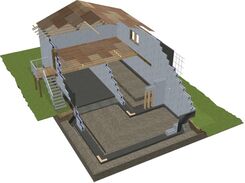- Home
-
Seminars
- Step 3 Mandatory Training
- The Fundamentals of Building Science
- Building the House of Tomorrow
- The ICF Series
- What's On Top
- Your Design, Your Way
- The Mechanicals Series
- Seismic Bracing Requirements
- Cladding & Accessories Installation
- Changes to Part 9
- Spring Session 2018
- Top Tier Methods to Net Zero Houses
- The Details Series
- Spring Session 2017
-
Online Courses
-
Courses by Name
>
- The Phoenix : Designing and Rebuilding our House of Tomorrow
- Part 9 Code Changes for the BC Building Code 2024
- The Fundamentals of Building Science
- Step 3 Mandatory Training
- Building The House of Tomorrow
- The ICF Series
- What's On Top
- Your Design, Your Way
- Mechanicals Online
- Asbestos Awareness
- Intro to WHMIS
- Seismic Bracing Requirements
- Cladding & Accessories Installation (Fall 2018)
- Understanding Insulation Performance
- Top Tier Methods to Net Zero Houses (Fall 2017)
- The Details
- Spring 2017 Sessions
- Top 10 Warranty Claims
-
Courses By Topic
>
-
Courses by Name
>
- Hands-On
- CPD at Sea
- More
- CSA F280 Report
Presented Live, September 2021 - December 2021

The widespread use of ICF has been successfully practiced in North America for more than 40 years. As a foundation system, ICF brings many efficiencies, advanced energy, and improved hydrothermal performance when compared to the typical insulated concrete basement wall. Concerns about voids in the concrete, the embodied energy associated with plastic insulation and concrete, and the higher cost associated with ICF in general, have contributed to the hesitation of the construction industry to completely embrace this valid construction type. Many changes in the production of foamed plastics, concrete technology and advanced concrete mixes and placement techniques, are eroding many past concerns. More recently the requirements for higher energy efficiency and recognition of the extraordinary durability of ICF as a building system is now resulting in the cost of this form of construction meeting or beating traditional, light weight wood frame methods. Enjoy this series as we introduce the basics of ICF construction and explain the extraordinary deliverable performance and durability of this increasingly popular option for designers, builders and homeowners alike.
Session 1: ICF Below Grade
This session leads off with an overview of a generic ICF block Insulating Concrete Form (ICF) system including Part 9 reinforcement, concrete placement and transition and penetration detailing. The requirements relating to footing design and construction, damp proofing and waterproofing, reinforcement, openings for pipes, electrical, basement windows and doors, as well as transition details to various walls above grade (including ICF), ledger attachments, and concrete placement/consolidation will be examined in detail. Advanced CGI graphics, photo’s and video will help to explain the basics of ICF in below grade applications. Tips, tricks and qualify assurance information will also be presented.
Session 2: ICF Above Grade
ICF has always been an option from footing to the roof line, and more industry designers and builders are exploring the use of ICF as more than just a high performance, durable basement or crawlspace option. In this session, an overview of the same generic ICF block used to form above below grade walls will be explored. The unique requirements for reinforcement above grade, and penetration detailing including alternate methods of integrating windows, doors, plumbing and electrical elements through the massive wall assembly that is ICF. The session will be include supporting graphics, photo’s and video to ensure clarity of the steps required to produce highly durable, energy efficient and cost effective homes with these products.
Session 3: The Energy Advantage of ICF
Once upon a time, an R value was an R value. It was a measure of the thermal resistance of an insulating material or layer. When our walls were effective R 2 (2 x 4 with no insulation), or R 4 (when we filled those walls with sawdust and other interesting materials) or R 8 (with 2 x 4 batt) and then R 16 (2 x 6 walls with batt), the effective insulating value of the entire wall assembly was reasonably close to the value of the insulation that we used to improve that performance. This session explains how energy performance must now be evaluated as we move towards Net Zero homes by 2032, and how the actual thermal performance of ICF has always been significantly greater than the nominal R value of the polystyrene ICF forms themselves. Thermal massing, effective insulation values and many other mysteries will be clearly and simply explained. This will also provide the tools to understand why ICF has always delivered much higher thermal performance and high lateral load resistance but is only now getting the credit it deserves under the recent evolution of building codes in Canada.
Session 4: The Continuity of the Enclosure with ICF
The house as a whole, or system, is the new language of designers and builders. With advanced energy efficiency comes the need for a finely balanced approach to every choice; from fenestration, to mechanical, to thermal layers, and the continuity of the planes of protection. ICF is a robust and highly durable building system and can be more forgiving when exposed to excessive environmental loads, but too much of anything one element can quickly have a very negative effect on affordability and even performance. This session will dive into continuity of the planes of protection and discuss balanced approaches to the whole house design. This will highlight some very interesting and somewhat unexpected changes in how we design and built these homes.
Session 5: Manufacturers Options Below Grade
The session will present an introduction to a cross-section of specific available manufacturers proprietary systems and industry support resources for the new and veteran user of ICF for below grade walls. An examination of the specific manufacturers requirements, accessories, and particular methods to ensure that the installation of specific systems conforms with the requirements outlined in Part 9. This session goes further to explore expanded capabilities when using specific ICF blocks with the assistance of professional design and oversight.
Session 6: MANUFACTURERS OPTIONS ABOVE GRADE
The session will be rounded out with an introduction to a cross-section of specific available manufacturers proprietary systems and industry support resources for the new and veteran user of ICF for above grade walls. An examination of the specific manufacturers requirements, accessories, and particular methods to ensure that the installation of specific systems conforms with the requirements outlined in Part 9. This session goes further to explore expanded capabilities when using specific manufacturers' ICF blocks with the assistance of professional design and oversight.
If you need any assistance please call our office at (604) 464-0596. Our office is open Monday-Friday 8:30am to 5:00pm
|
Copyright 2015 - 2025 Constructive Home Solutions Inc.
|




